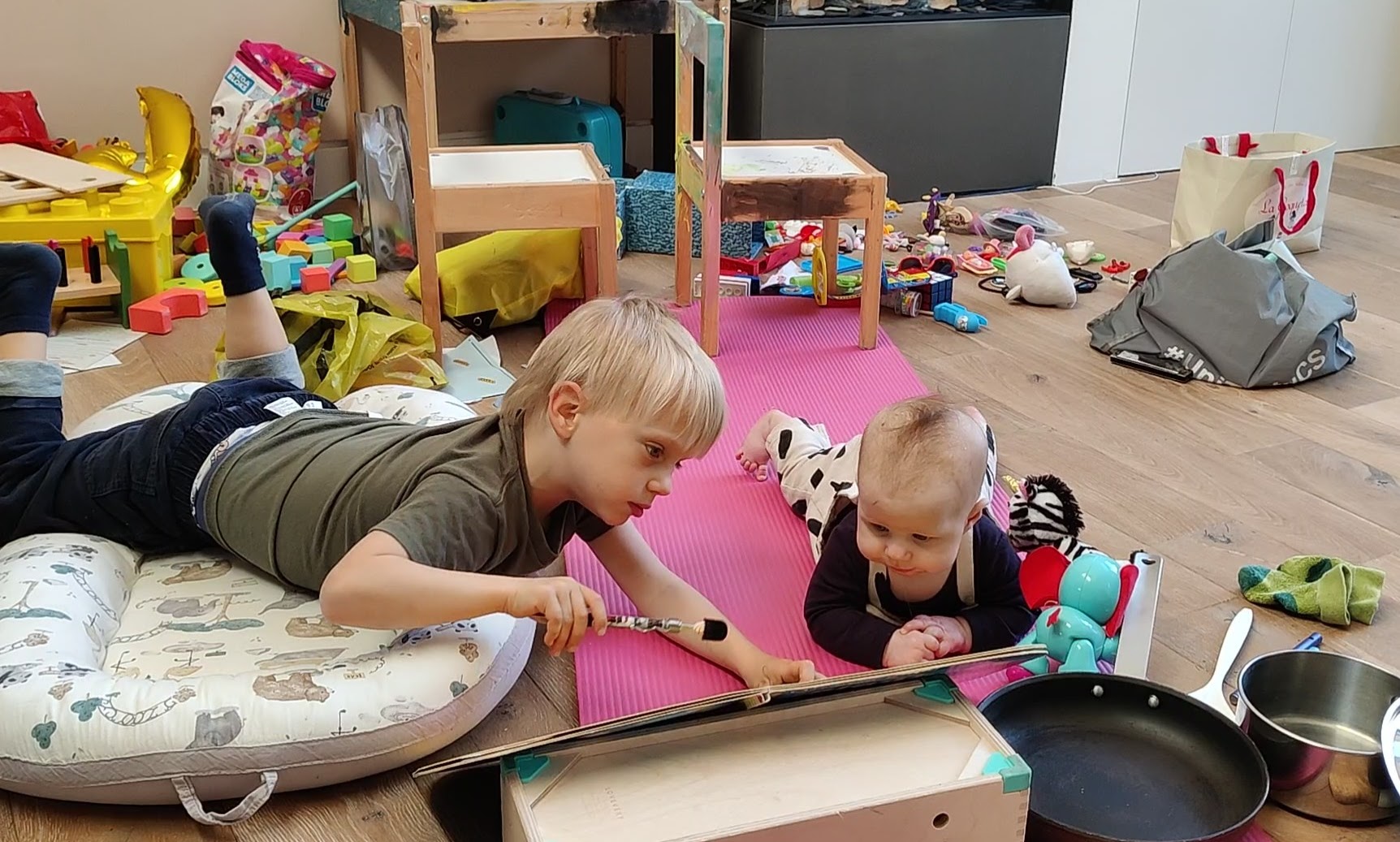What is the gender pay gap?
The gender pay gap is an initiative from the UK government to help reduce the difference in pay between men and women. Since 2017, companies with more than 250 employees have had to report a series of figures annually on the 5 April, as a snapshot of the previous year’s data. This is a UK-specific metric, so currently only applies to our London office.
The gender pay gap is the difference in average hourly earnings between men and women working within the same organisation. It shows us how women and men are being paid across the team and helps us understand whether women are represented in senior roles, and in the best paid areas of the business such as product and engineering.
In this report, gender definitions are based on current legal definitions. However, we recognise that not everyone’s gender identity fits within this binary, and not everyone is yet legally able to be defined as the gender that they would like to be. In the near future, we’re planning to make this more inclusive and allow employees to list the gender (if any) that they most identify with.
How is the gender pay gap different to equal pay?
The 1970 Equal Pay Act made it illegal to pay people doing the same job differently based on gender, a ruling which has since expanded to cover other protected characteristics. Wise is fully compliant with the Equal Pay Act.
The gender pay gap, however, is a more broad overview of the salaries and benefits earned by men and women within Wise, regardless of their role or seniority.
In addition, Wise uses a benchmarking and pay banding system to make sure everyone is paid equally for the same role regardless of gender, race, religion or any other factor. We also make all our pay bands available for employees to view internally, to increase transparency and empower our people.
What is Wise’s pay gap?
On 5 April 2020, Wise had over 370 people working in its London office. 30% of the London team were women, 70% were men. To calculate this data, we’ve used the legal gender of team members when they joined the business.
Wise’s pay gap looked like this.
2020
| | Women | Men | Pay Gap |
|---|
| Mean hourly pay | £28.71 | £37.50 | 23.43% |
| Median hourly pay | £27.31 | £35.93 | 24.00% |
* Data for 2020 is taken as of April 2020 payroll, on the 5th April 2020
And in order to understand how things have changed since last year, we’ve also included our 2019 numbers for comparison.
2019
| | Women | Men | Pay Gap |
|---|
| Mean hourly pay | £27.55 | £35.92 | 23.32% |
| Median hourly pay | £23.95 | £33.54 | 28.57% |
* Data for 2019 is taken as of April 2019 payroll, on the 5th April 2019
Our mean hourly pay gap has increased by 0.11 percentage points, and our median hourly pay gap has reduced by almost 4.57 percentage points. While improvement across our median pay gap is promising to see, it’s clear we still have some issues to address to achieve parity.
However, a brief review of the latest figures show that, as of 11th March 2021, we already reduced the mean hourly pay gap to 18.22%, a drop of 5.2 percentage points since April 2020, showing that our initiatives are moving us in the right direction.
Are bonuses included in the pay gap?
The Government asks us to publish the same figures for bonuses, as these are kept separate from the pay gap data. Wise doesn’t offer any employee a traditional annual bonus, choosing to offer stock in the business instead. The number of stock options¹ allocated is benchmarked by role and experience level, and those who have been with the business for longer could have more options than newer joiners.
Wise grants Non-qualified stock options² (NSOs) to its employees. Within the UK, Wise originally offered employees share options via the EMI³ or CSOP⁴ schemes, which are employee tax advantage schemes designed for smaller companies.
Since 2017, our people have had a number of opportunities to sell a portion of their share options via secondary fundraising events. NSOs are classified as part of a company's bonus structure as defined by the UK Government, so any stock options sold from this scheme are included in the bonus numbers below.
Options sold by people holding EMI and CSOP options are not included, and likewise it is up to the individual as to whether they choose to hold, or sell, their options via our secondary sales. As such, the numbers below are not a complete view.
Other benefits offered at Wise which class as bonuses are: refer a friend to work at Wise (£1000), a £1000 gift alongside a six week paid sabbatical for employees who serve four years with the firm, and relocation allowances.
While it's our employees' own choice to sell their stock options, and when, we wanted to share this information for transparency.
2020
| | Women | Men | Bonus Gap |
|---|
| Mean bonus | £7,437.84 | £29,609.35 | 86.66% |
| Median bonus | £2,200.00 | £2,200.00 | 0.00% |
What does the gender pay split look like at Wise?
We also split everyone in the London office into four equal quartiles from the lowest to the highest paid. Last year, we saw a higher percentage of men in the upper and upper middle quartiles, and more women in the lower quartiles. While this broadly remains the case, this year we have reduced the number of women in the lowest quartile by 3%, and seen this lead to an increase across higher quartiles in the business.
| | 2020 | | 2019 | |
|---|
| | Women | Men | Women | Men |
| Top | 18% | 82% | 16% | 84% |
| Upper middle | 15% | 85% | 17% | 83% |
| Lower middle | 28% | 72% | 22% | 78% |
| Lower | 55% | 45% | 58% | 42% |
Why do we have a pay gap?
Wise is a large business; we’ve grown very quickly, and continue to do so. Today we have over 2,400 people across fourteen global offices, and since the 2020 reporting date our London team has expanded from over 370 to 489 people. We’ve also been working on a hiring drive, to add an additional 750 people to the business globally between December 2020 and June 2021, with 175 of these set to be in the UK.
In addition, our London office is home to a range of different people working at various job levels, including our senior leadership team, a high proportion of product managers and engineers, as well as Marketing, Design, People, Finance and Legal teams.
As with many technology companies, a significant proportion of our highest paying roles still sit within our engineering team, a discipline which has a history of being very male dominated. Our founders are male, and a large portion of the senior leadership team based out of the UK office are predominantly male, meaning that these factors heavily influence our gender pay gap.
While these elements go some way in explaining our pay gap, they by no means justify it. We have identified these causes as key areas we need to work on long term, to improve Wise’s gender diversity, and we are actively encouraging more women to apply to technology roles and senior leadership positions.
How are we solving this?
We’re committed to closing Wise’s gender pay gap, and have identified four areas we are concentrating on:
1. Building an inclusive recruitment process to help bring in, and support, more female applicants
- Created new inclusive job ad templates to help reduce bias language in our recruitment processes.
- Published career maps and salary bands for all teams in Wise, including Engineering, Analytics and Product.
- Introduced ‘values based interview training’ to evaluate candidates fairly and consistently, with added structure that supports a more objective selection process when assessing candidates.
- Team leads, and recruitment leads have also undertaken unconscious bias training to expose any implicit biases that might impact their decisions.
2. Widening the funnel to help diverse Engineering candidates find Wise
- Built a sourcing strategy for female engineers, using tactics like female engineering sourcing sessions, referral drives, and working with our female engineers to help us reach out to candidates.
- Proactively headhunting female engineering candidates across all levels of experience.
- Our goal is to make sure that 25% of incoming applicants, and 20% of all Engineering Lead hires are female by the end of 2021.
While recruiting more women, and more women into engineering roles is important, inclusion is crucial in ensuring that they feel supported through their journey at Wise. To ensure this, we are launching a project to increase inclusion in our engineering team, in partnership with our engineering leads.
3. Headhunting and promoting women into senior leadership
- We have recently announced the appointment of two new Non Executive Directors, Clare Gilmartin (former CEO of the Trainline) and Hooi Ling Tan (co-founder Grab), and we will be adding more board appointments over the coming years, headhunting only female candidates.
- We’re committed to increasing the number of women in leadership at Wise. We’re currently finalising a program of clearly defining leadership roles, and pathways to progression, to help us better measure and track our progress against this.
- Our marketing team has committed to sourcing at least 50% female and non-binary candidates for all roles, and a target of 50% women in Senior Leadership by the end of 2022.
4. Investing in a Diversity & Inclusion expert
As of January 2021, we welcomed our first dedicated Diversity and Inclusion Lead. Along with focusing on our current projects to increase diversity in our engineering and product teams, this role will also look at demographic data and measurement within Wise to help us take positive action and make meaningful progress on our journey towards becoming a truly inclusive and diverse company.
By doing this, we aim to identify more ways to improve our current diversity and inclusion standards, and also understand the experience of team members from all backgrounds, and how we can better serve their needs.
At Wise we’re proud to be an inclusive and mission-driven employer. We know that in order to cater to a diverse workforce we need to offer a range of benefits and policies for different people and circumstances. For example, maternity and paternity pay and generous shared parental leave entitlements. At Wise, all parents are able to take the first 6 months off following the birth or adoption of a child, and this time is fully paid.
However, our pay gap shows we still have work to do when it comes to bringing more women into our senior team, and in product and engineering roles. We’re committed to improving our position, and believe that through our long-term recruitment plans, and continued investment into D&I at Wise, we can improve our gender diversity in these sectors.
We know that better diversity means stronger, more experienced teams, as well as a more relevant product for our customers. To achieve Wise’s longer term mission, we need to fix the pay gap, and make sure we leave no-one behind on our journey to achieve money without borders, for everyone.
Glossary:
-
A stock option is the right to buy a set number of shares at a fixed price, often called the strike price, grant price, or exercise price. The price is usually determined by the fair market value, or whatever the shares are worth when you’re granted the options.
-
NSOs are Non-Qualified stock options.They are a type of employee stock option where you pay ordinary income tax on the difference between the grant price and the price at which you exercise.
-
The Enterprise Management Incentive (EMI) option scheme designed for smaller companies. The EMI is a share option scheme that enables companies to attract and retain key staff by rewarding them with equity participation in the business.
-
The CSOP is a tax qualified discretionary option plan under which a company may grant options to any employee to acquire shares at an exercise price which must be no less than the market value of the shares on the grant date.
*Please see terms of use and product availability for your region or visit Wise fees and pricing for the most up to date pricing and fee information.
This publication is provided for general information purposes and does not constitute legal, tax or other professional advice from Wise Payments Limited or its subsidiaries and its affiliates, and it is not intended as a substitute for obtaining advice from a financial advisor or any other professional.
We make no representations, warranties or guarantees, whether expressed or implied, that the content in the publication is accurate, complete or up to date.









